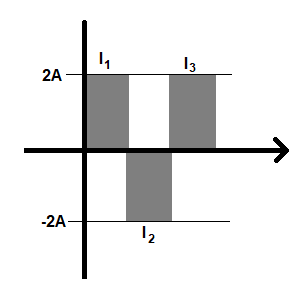
Calculate the rms value of A.C. as shown in the figure.


Answer
582.3k+ views
Hint: The full form of rms value is root mean square value. The meaning of root mean square is the square root of the mean of the squares of the given values. It is an alternative for mean value of given numbers. Sometimes, it is more useful than mean value.
Complete step by step answer:
Sometimes when we find the mean (average) value of the values of an oscillating function, we get the mean value as zero. This is because the function has both positive as well as negative values and the sum is zero, making the value of mean zero. However, zero signifies nothing and we do not want that.
For example, take an alternating current that is a sinusoidal function of time, $i={{i}_{\circ }}\sin (\omega t)$. The mean value of a sine function for an interval of $2\pi $is zero. However, this value cannot help us to understand the circuit.
Due to this reason, we have an alternative way for an average value of multiple values and that is root mean square value (rms value).
Rms value of a function is the root mean square value. It is the square root of the mean of the squares of the numbers. It is always positive.
Let us calculate the root mean square value for the given data.

There are three values of current, ${{I}_{1}}$, ${{I}_{2}}$ and ${{I}_{3}}$. If we look at the figure, the values of ${{I}_{1}}$, ${{I}_{2}}$ and ${{I}_{3}}$ are 2A, -2A and 2A. The rms value of this values will be ${{I}_{rms}}=\sqrt{\dfrac{{{I}_{1}}^{2}+{{I}_{3}}^{2}+{{I}_{3}}^{2}}{3}}$.
First, let us calculate the mean of the squares (${{I}^{2}}_{mean}$) of the three current values. For the mean of squares, calculate the sum of the squares of the three currents and divide the sum by 3 since there are three currents.
Therefore, $\begin{align}
& {{I}^{2}}_{mean}=\dfrac{{{I}_{1}}^{2}+{{I}_{3}}^{2}+{{I}_{3}}^{2}}{3} \\
& \text{ }=\dfrac{{{\left( 2 \right)}^{2}}+{{\left( -2 \right)}^{2}}+{{\left( 2 \right)}^{2}}}{3}=\dfrac{4+4+4}{3}=\dfrac{12}{3}=4 \\
\end{align}$
The root mean value will be ${{I}_{rms}}=\sqrt{{{I}^{2}}_{mean}}=\sqrt{4}=2$
Therefore, the rms value of the three given current values is 2A.
Note: In this problem, there were only three current values. Sometimes there are infinite values in a function e.g. $i={{i}_{\circ }}\sin (\omega t)$. If you take an interval of time in this function, the root mean square value for this interval cannot be calculated by a simple summation. Here, we have to integrate the function with time for the given interval i.e. $\int{i.dt=}\int{{{i}_{\circ }}\sin (\omega t).dt}$.
Complete step by step answer:
Sometimes when we find the mean (average) value of the values of an oscillating function, we get the mean value as zero. This is because the function has both positive as well as negative values and the sum is zero, making the value of mean zero. However, zero signifies nothing and we do not want that.
For example, take an alternating current that is a sinusoidal function of time, $i={{i}_{\circ }}\sin (\omega t)$. The mean value of a sine function for an interval of $2\pi $is zero. However, this value cannot help us to understand the circuit.
Due to this reason, we have an alternative way for an average value of multiple values and that is root mean square value (rms value).
Rms value of a function is the root mean square value. It is the square root of the mean of the squares of the numbers. It is always positive.
Let us calculate the root mean square value for the given data.

There are three values of current, ${{I}_{1}}$, ${{I}_{2}}$ and ${{I}_{3}}$. If we look at the figure, the values of ${{I}_{1}}$, ${{I}_{2}}$ and ${{I}_{3}}$ are 2A, -2A and 2A. The rms value of this values will be ${{I}_{rms}}=\sqrt{\dfrac{{{I}_{1}}^{2}+{{I}_{3}}^{2}+{{I}_{3}}^{2}}{3}}$.
First, let us calculate the mean of the squares (${{I}^{2}}_{mean}$) of the three current values. For the mean of squares, calculate the sum of the squares of the three currents and divide the sum by 3 since there are three currents.
Therefore, $\begin{align}
& {{I}^{2}}_{mean}=\dfrac{{{I}_{1}}^{2}+{{I}_{3}}^{2}+{{I}_{3}}^{2}}{3} \\
& \text{ }=\dfrac{{{\left( 2 \right)}^{2}}+{{\left( -2 \right)}^{2}}+{{\left( 2 \right)}^{2}}}{3}=\dfrac{4+4+4}{3}=\dfrac{12}{3}=4 \\
\end{align}$
The root mean value will be ${{I}_{rms}}=\sqrt{{{I}^{2}}_{mean}}=\sqrt{4}=2$
Therefore, the rms value of the three given current values is 2A.
Note: In this problem, there were only three current values. Sometimes there are infinite values in a function e.g. $i={{i}_{\circ }}\sin (\omega t)$. If you take an interval of time in this function, the root mean square value for this interval cannot be calculated by a simple summation. Here, we have to integrate the function with time for the given interval i.e. $\int{i.dt=}\int{{{i}_{\circ }}\sin (\omega t).dt}$.
Recently Updated Pages
A man running at a speed 5 ms is viewed in the side class 12 physics CBSE

The number of solutions in x in 02pi for which sqrt class 12 maths CBSE

State and explain Hardy Weinbergs Principle class 12 biology CBSE

Write any two methods of preparation of phenol Give class 12 chemistry CBSE

Which of the following statements is wrong a Amnion class 12 biology CBSE

Differentiate between action potential and resting class 12 biology CBSE

Trending doubts
What are the major means of transport Explain each class 12 social science CBSE

Which are the Top 10 Largest Countries of the World?

Draw a labelled sketch of the human eye class 12 physics CBSE

How much time does it take to bleed after eating p class 12 biology CBSE

Explain sex determination in humans with line diag class 12 biology CBSE

Explain sex determination in humans with the help of class 12 biology CBSE




